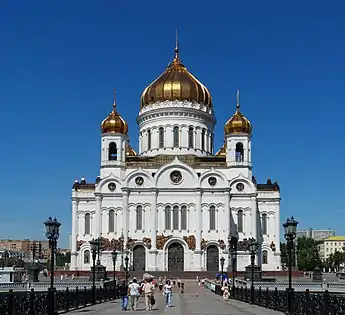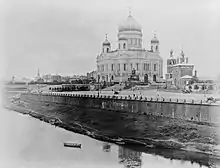Cathedral of Christ the Saviour
The Cathedral of Christ the Saviour (Russian: Храм Христа́ Спаси́теля, tr. Khram Khristá Spasítelya, IPA: [xram xrʲɪˈsta spɐˈsʲitʲɪlʲə]) is a Russian Orthodox cathedral in Moscow, Russia, on the northern bank of the Moskva River, a few hundred metres southwest of the Kremlin. With an overall height of 103 metres (338 ft),[4] it is the third tallest Orthodox Christian church building in the world, after the People's Salvation Cathedral in Bucharest, Romania[5] and Saints Peter and Paul Cathedral in Saint Petersburg, Russia.
| Cathedral of Christ the Saviour | |
|---|---|
Храм Христа Спасителя Khram Khrista Spasitelya | |
 The new Cathedral of Christ the Saviour as viewed from the bridge over the Moscow River | |
 Cathedral of Christ the Saviour | |
| 55°44′40″N 37°36′20″E | |
| Location | Moscow, Russia |
| Denomination | Russian Orthodox |
| Website | www |
| History | |
| Consecrated | 19 August 2000 |
| Architecture | |
| Style | Russian Revival |
| Specifications | |
| Capacity | 10,000 people[1] |
| Length | 79 m (length-width)[1] |
| Height | 103.4 m (top cross)[2] 91.5 (top dome)[2] 69.5 (dom ceiling)[2] |
| Nave height | 37 m (interior)[1] |
| Other dimensions | 194,900 m3 [2] |
| Floor area | 3,980 m2[3] |
| Dome diameter (outer) | 29.8 m[2] |
The current church is the second to stand on this site. The original church, built during the 19th century, took more than 40 years to build, and was the scene of the 1882 world premiere of the 1812 Overture composed by Tchaikovsky. It was destroyed in 1931 on the order of Soviet leader Joseph Stalin. The demolition was supposed to make way for a colossal Palace of the Soviets to house the country's legislature, the Supreme Soviet of the USSR. Construction started in 1937 but was halted in 1941 when Germany invaded the Soviet Union during World War II. Its steel frame was disassembled the following year, and the Palace was never built. Following the dissolution of the Soviet Union, the current church was rebuilt on the site between 1995 and 2000.
Original cathedral
Construction
When Napoleon Bonaparte retreated from Moscow, Tsar Alexander I signed a manifesto on 25 December 1812 declaring his intention to build a cathedral in honor of Christ the Saviour "to signify Our gratitude to Divine Providence for saving Russia from the doom that overshadowed Her" and as a memorial to the sacrifices of the Russian people. It took some time for work on the projected cathedral to get started. The first finished architectural project, by Aleksandr Lavrentyevich Vitberg, was endorsed by the Tsar in 1817. It was a flamboyant Neoclassical design full of Freemasonic symbolism.

Construction work was begun on the Sparrow Hills, the highest point in Moscow, but the site proved unstable. In the meantime Alexander I was succeeded by his brother Nicholas I. Profoundly Orthodox and patriotic, the new Tsar disliked the Neoclassicism and Freemasonry of the design selected by his predecessor. He commissioned his favorite architect Konstantin Thon to create a new design, taking as his model Hagia Sophia in Constantinople, Turkey. Thon's Russian Revival design was approved in 1832. A new site closer to the Moscow Kremlin was chosen by the Tsar in 1837. A convent and church on the site had to be relocated, so the cornerstone of the new church was not laid until 1839.
The cathedral took many decades to build; the scaffolding was not taken down until 1860. Its painting was overseen by Evgraf Sorokin, and thereafter some of the best Russian painters (Ivan Kramskoi, Vasily Surikov, V. P. Vereshchagin) continued to embellish the interior for another twenty years. The giant dome of the cathedral was gilded using the new technique of gold electroplating, replacing the older and insecure technique of mercury gilding.[6] Although Tchaikovsky's 1812 Overture was written with the building's completion in mind, it had its world premiere in a tent outside the unfinished church in August 1882. The cathedral was consecrated on 26 May 1883, the day before Alexander III was crowned.[7]
The inner sanctum of the church (naos) was ringed by a two-floor gallery, its walls inlaid with rare sorts of marble, granite, and other stones. The ground floor of the gallery was a memorial dedicated to the Russian victory over Napoleon. The walls displayed more than 1,000 square metres (11,000 sq ft) of Carrara bianca marble plaques listing major commanders, regiments, and battles of the Patriotic War of 1812 (with the lists of awards and casualties appended). The second floor of the gallery was occupied by church choirs.
Demolition


Following the 1917 Russian Revolution, the USSR's official state atheism resulted in the 1921-1928 anti-religious campaign, during which many "church institution[s] at [the] local, diocesan or national level were systematically destroyed."[8] Following the death of Vladimir Lenin in 1924, Soviet leader Joseph Stalin chose the prominent site of the cathedral as the proposed site for a monument to socialism known as the Palace of the Soviets. It was to have modernistic, buttressed tiers to support a gigantic statue of Lenin perched on top of a dome with his arm raised in the air.
The government plans for economic development in Russia during the 1930s required more funds than were available at the time. In searching for additional sources of revenue and funding, government agencies saw monetary value in religious and historical monuments that had not yet been destroyed or otherwise repurposed for government use. On 24 February 1930, the economic department of the OGPU sent a letter to the Chairman of the Central Executive Committee asking to remove the golden domes of the Christ the Saviour Cathedral. The letter noted that the dome of the church contained over 20 tons of gold of "excellent quality", and that the cathedral represented an "unnecessary luxury for the Soviet Union, and the withdrawal of the gold would make a great contribution to the industrialization of the country." The People's Commissariat of Finance did not object to this proposal.[9]
On 5 December 1931, by order of Stalin's minister Lazar Kaganovich, the Cathedral of Christ the Saviour was dynamited and reduced to rubble. It took more than a year to clear the debris from the site. The construction of the Palace of Soviets was ultimately halted due to a lack of funds, problems with flooding from the nearby Moskva River, and the outbreak of World War II. Some of the marble from the walls and benches of the cathedral was used in nearby Moscow Metro stations. The original marble high reliefs were preserved and are now on display at the Donskoy Monastery. For many decades, these reliefs were the only reminders of one of the largest Orthodox churches ever built. The flooded foundation hole remained on the site, but in 1958 under Nikita Khrushchev, it was transformed into the world's largest open air swimming pool, named Moskva Pool.
Rebuilt cathedral


In February 1990, the Russian Orthodox Church received permission from the Soviet government to rebuild the Cathedral of Christ the Saviour. A temporary cornerstone was laid by the end of the year. The architect Aleksey Denisov was called upon to design a replica, but was soon fired from the project because of disagreements with the Mayor’s office.[10] When construction was well under way, he was replaced by Zurab Tsereteli, who introduced several controversial innovations. For instance, the original marble high reliefs along the walls were replaced by modern bronze ones, which have few, if any, parallels in Russian church architecture.
A construction fund was initiated in 1992 and funds began to pour in from citizens in the autumn of 1994, and about one million Muscovites donated money for the project. In this year the Moskva Pool was demolished and the cathedral reconstruction commenced. The lower church was consecrated to the Saviour's Transfiguration in 1997, and the completed Cathedral of Christ the Saviour was consecrated on the Transfiguration Day, 19 August 2000.

Below the new church is a large hall for church assemblies. The cathedral square is graced by several chapels, designed in the same style as the cathedral. A footbridge across the river from Bersenevskaya embankment was constructed between 21 June 2003 and 3 September 2004 (photo). On the slope of the hill to the right of the cathedral are the monumental statues of Alexander II and Nicholas II.
Significant events
In 2000 the cathedral was the venue for the Canonization of the Romanovs when the last Tsar Nicholas II and his family were glorified as saints. On 17 May 2007, the Act of Canonical Communion between the Moscow Patriarchate of the Russian Orthodox Church and the Russian Orthodox Church Outside Russia was signed there. The ROCOR had been separate since the 1920s. The full restoration of communion with the Moscow Patriarchate was celebrated by a Divine Liturgy at which the Patriarch of Moscow and All Russia, Alexius II and the First Hierarch of ROCOR, Metropolitan Laurus, concelebrated the Divine Liturgy for the first time in history.
The first Russian President Boris Yeltsin, who died of heart failure on 23 April 2007, lay in state in the cathedral prior to his burial in Novodevichy Cemetery.
In 2009 the cathedral was visited by Metropolitan Jonah (Paffhausen), former primate of the Orthodox Church in America, who celebrated the Liturgy with Patriarch Kirill I. Metropolitan Jonah later described the event, saying that even with a congregation of approximately 2,500, the vast church was only half full. About 16 bishops attended the ordination of a new bishop that day.[11]
Russian feminist punk rock group Pussy Riot staged a guerrilla performance in the cathedral in February 2012 in protest against the Russian Orthodox Church's support for Vladimir Putin.[12][13] Three members were jailed for hooliganism.
See also
Notes
References
- "Храм Христа Спасителя".
- "Основные размеры Храма Христа Спасителя".
- Dmitri Sidorov 2000: National Monumentalization and the Politics of Scale: The Resurrections of the Cathedral of Christ the Saviour in Moscow. Annals of the Association of American Geographers, Vol. 90, No. 3 (Sep., 2000), pp. 548-572 (PDF)
- "ХРАМ ХРИСТА СПАСИТЕЛЯ". www.xxc.ru. Archived from the original on 2 December 2010. Retrieved 5 January 2018.
- The Visual Dictionary of Architecture. AVA Publishing. 2007. p. 78. ISBN 978-2940373543.
- The history of galvanoplating in Russia Archived 5 March 2012 at the Wayback Machine (in Russian)
- Manaev, G. (18 December 2019). "10 LOST architectural wonders of Moscow (PHOTOS)". Russia Beyond the Headlines. Retrieved 29 January 2020.
- Eastern Europe, Russia and Central Asia. Taylor & Francis. 2002. p. 46. ISBN 1857431375.
- Ратьковский И.С., Ходяков М.В. (1999). История Советской России, Изд-во "Лань", pp. 137-149.
- "Moscow's Iconic Cathedral Was Restored Wrongfully on Cursed Location". Retrieved 24 September 2009.
- "Conversations with Metropolitan Jonah: Ministry, Monasticism, and the Episcopacy". 2 June 2009. Archived from the original on 2 November 2010. Retrieved 3 June 2009.
- Rumens, Carol (20 August 2012). "Pussy Riot's Punk Prayer is pure protest poetry". TheGuardian.com. Guardian News & Media. Retrieved 13 January 2019.
- Pussy Riot gig at Christ the Saviour Cathedral (original video). 2 July 2012. Archived from the original on 24 August 2012. Retrieved 1 September 2012.
External links
| Wikimedia Commons has media related to Cathedral of Christ the Saviour. |
- Travel2moscow.com – Official Moscow Guide
- Official website, with full details of the construction and reconstruction history.
- Cathedral of Christ the Saviour in Moscow by Evgenia Kirichenko
- Cathedral of Christ the Saviour in Moscow: A Russian Allegory
- Churches Around the World Archive
- 360° Virtual Tour of the Cathedral of Christ the Saviour